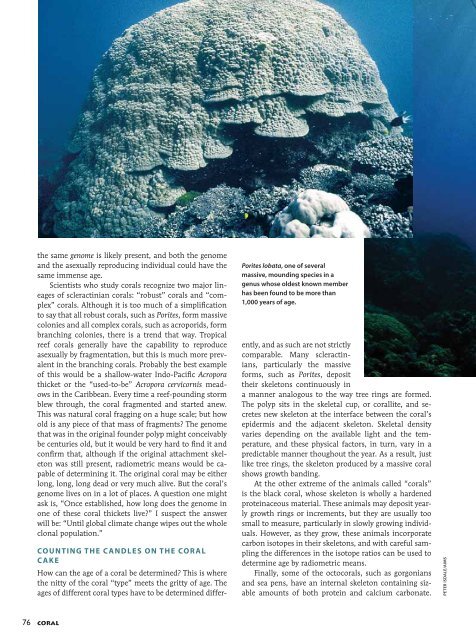You also want an ePaper? Increase the reach of your titles
YUMPU automatically turns print PDFs into web optimized ePapers that Google loves.
the same genome is likely present, and both the genome<br />
and the asexually reproducing individual could have the<br />
same immense age.<br />
Scientists who study corals recognize two major lineages<br />
of scleractinian corals: “robust” corals and “complex”<br />
corals. Although it is too much of a simplification<br />
to say that all robust corals, such as Porites, form massive<br />
colonies and all complex corals, such as acroporids, form<br />
branching colonies, there is a trend that way. Tropical<br />
reef corals generally have the capability to reproduce<br />
asexually by fragmentation, but this is much more prevalent<br />
in the branching corals. Probably the best example<br />
of this would be a shallow-water Indo-Pacific Acropora<br />
thicket or the “used-to-be” Acropora cervicornis meadows<br />
in the Caribbean. Every time a reef-pounding storm<br />
blew through, the coral fragmented and started anew.<br />
This was natural coral fragging on a huge scale; but how<br />
old is any piece of that mass of fragments? The genome<br />
that was in the original founder polyp might conceivably<br />
be centuries old, but it would be very hard to find it and<br />
confirm that, although if the original attachment skeleton<br />
was still present, radiometric means would be capable<br />
of determining it. The original coral may be either<br />
long, long, long dead or very much alive. But the coral’s<br />
genome lives on in a lot of places. A question one might<br />
ask is, “Once established, how long does the genome in<br />
one of these coral thickets live?” I suspect the answer<br />
will be: “Until global climate change wipes out the whole<br />
clonal population.”<br />
Porites lobata, one of several<br />
massive, mounding species in a<br />
genus whose oldest known member<br />
has been found to be more than<br />
1,000 years of age.<br />
COUNTING THE CANDLES ON THE CORAL<br />
CAKE<br />
How can the age of a coral be determined? This is where<br />
the nitty of the coral “type” meets the gritty of age. The<br />
ages of different coral types have to be determined differently,<br />
and as such are not strictly<br />
comparable. Many scleractinians,<br />
particularly the massive<br />
forms, such as Porites, deposit<br />
their skeletons continuously in<br />
a manner analogous to the way tree rings are formed.<br />
The polyp sits in the skeletal cup, or corallite, and secretes<br />
new skeleton at the interface between the coral’s<br />
epidermis and the adjacent skeleton. Skeletal density<br />
varies depending on the available light and the temperature,<br />
and these physical factors, in turn, vary in a<br />
predictable manner thoughout the year. As a result, just<br />
like tree rings, the skeleton produced by a massive coral<br />
shows growth banding.<br />
At the other extreme of the animals called “corals”<br />
is the black coral, whose skeleton is wholly a hardened<br />
proteinaceous material. These animals may deposit yearly<br />
growth rings or increments, but they are usually too<br />
small to measure, particularly in slowly growing individuals.<br />
However, as they grow, these animals incorporate<br />
carbon isotopes in their skeletons, and with careful sampling<br />
the differences in the isotope ratios can be used to<br />
determine age by radiometric means.<br />
Finally, some of the octocorals, such as gorgonians<br />
and sea pens, have an internal skeleton containing sizable<br />
amounts of both protein and calcium carbonate.<br />
PETER ISDALE/AIMS<br />
76 CORAL

















